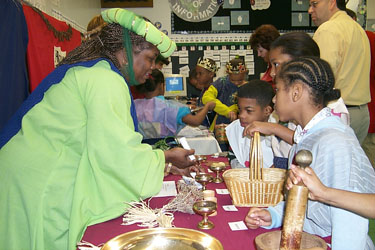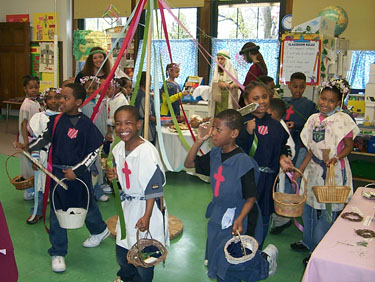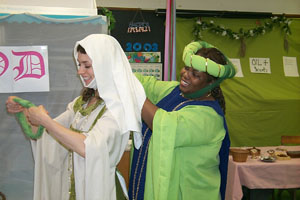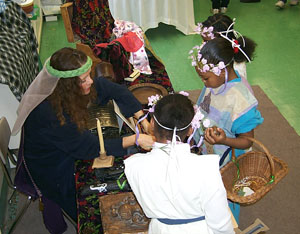Lesson Title:
Medieval
Fair and Marketplace
Author: Lucy Andrus
Grade/Age Level: Can be adapted for several grades
Written here for: Third Grade Inclusion Class
 |
 |
Conceptual Basis For This Lesson:
Unit/Theme, Relation of Lesson to the Unit, Major Concepts to be Learned:

We will learn how the marketplace in Medieval Europe was often held just before a feast was given and/or in conjunction with a fair, which provided an opportunity for peasant and noble person alike to set work aside for a respite of entertainment and merriment. Merchants sold the goods that they acquired from others to the lords and ladies that would come from other parts of the country for the feast. Since it is early May, the students will also learn about May Day, including the May Pole tradition as part of this festival celebrating the joy of spring’s rebirth and the coming of summer.
The students will journey back in time and see what it might have been like to visit the marketplace and attend festivities encompassing May Day celebrations.
A marketplace will be created so that the student can visit them to learn more about medieval culture while also experiencing what it is like to shop for goods and budget their money. The students will be provided with pouches containing coins so that they might purchase items for the festivities they will attend. The marketplace will include: a booth offering bread and cheese, two of the major staples of medieval diet; a booth selling oils and perfumes used to scent the self and surroundings; a booth selling herbs and spices, items used by medieval Europeans for cooking as well as medicinal purposes; and a booth selling “accessories”, such as hand-made jewelry items, headpieces, an Art Partners coat-of-arms badge, and accoutrements of knighthood and other noble pursuits.
Before the students enter the marketplace, they will don simple garments (to be slipped on right over clothing) that were made for them previously. The students’ will role-play being medieval lords, ladies, knights and peasants going to the marketplace before a big feast. Items they purchase will embellish their own attire and define their station, as well as provide food for a meal we will share together. Following our trip to the market, the students will participate in a May Pole dance, and then attend a mini-feast as our final activity for the year.

Learning
Standards
Goals Specific
to Lesson/Unit (reflecting NYS standards, & targeted learning areas. See
Abbreviation Key at end):
- Increase knowledge and understanding of medieval European culture (Std. 4, AH, A/C)
- Increase understanding and appreciation for artisans and artistry of medieval Europe (Std. 3 & 4, AC, AE)
- Develop greater appreciation for cultural diversity in lifestyle and aesthetic systems) (Std. 4, AH, AC, AE, S)
- Enhance understanding of self and others through cross-cultural connection (e.g., most cultures use marketplaces to sell their art works) (Std. 4, S)
- Enhance living skills in areas
of commerce: purchase and money management (L, PreV)
Tools Needed For
Application
Visuals:
- Teacher-made: map of Medieval Europe; May Pole; other, see below under Booths.
- Art Resources: artifacts, posters, reproductions like Raphael’s St. George and the Dragon, examples of illuminated manuscripts, including the students’ work, etc., and any other “medieval” items to decorate.
Materials and Preparation:
Prepare:
- Simple cloth pouches (cut circle from cloth, snip hole around edge, weave ribbon through holes and use as drawstring to pull pouch closed); make pouch large enough to hold money as well a purchased goods.
- Simple garments, one for each child: purchase inexpensive pillowcases from a place like Amvets; cut neck hole and armholes (can even cut open side seams for ease); cut lengths of old sheet for belt; garment slips over child’s head and ties with cloth belt; distinguish a knight’s tunic by cutting and gluing on a red felt cross shape.
- Clean cloth pieces for wrapping purchased food goods in
- Signs for each booth stating wares and prices (nothing higher than 2 or 3 cents!). Make on computer in Old English or other suitable font
- Make name labels for the oils
- Make signs for spices and herbs
- May Pole and ribbons to use in the May Pole dance (S/Ts will do this)
- Make goods to sell at booths as possible depending on your time and budget (see individual booth details below). Some possibilities:
- Design and make an Art Partners coat-of-arms for each child from felt (optional)
- swords cut from cardboard that has been spray-painted silver (can embellish with glued on jewels, or simple drawn details using black Sharpie marker
- sword holders fashioned from copper or other inexpensive wire so that holder hangs from belt.
- hennins (steeple hats) cut from colored poster board, stapled, and embellished with a flowing ribbon or piece of light, gauzy fabric stapled to the tip
- simple cut paper crowns from gold colored paper
- May Day circlets of flowers with ribbon glued to end to tie on head
- simple bracelets made from braided embroidery floss, and/or cut and shaped copper wire purchased from a hardware store
- bunches of dried herbs tied together and ready to hang at booth, and smaller bunches or sprigs to be sold (we have a gardener on our teacher team who grows and dries herbs!)
- small drawstring potpourri pouches to package and sell some herbs
Gather:
- Artifacts
- 10 Table cloths (can use old sheets as well)
- Boom box and CD of Medieval music
- Pennies, handful for each child
- Bodhran drum, cymbals, recorder
- 6 tables: one for each booth, one for artifacts, one for feast/foods
- Medieval costumes for the teachers
- Baskets with handles for food booth (and other booths, if possible)
- Mortar and pestle sets
- Wooden bowls, lavender petals, tea towels for washing fingertips before feast
- Fill pouches with pennies (15 per child)
- Mirror
- Masking tape
DETAILS ON ITEMS NEEDED FOR EACH BOOTH:
- Use piece of masking tape to label any baskets with the students’ names before we begin
- Have for each booth for after the fair: wooden bowls, pitchers of water, lavender buds, and towels for washing and drying fingertips in lavender water (sprinkle buds into bowl of water). This will be done after the students have gone through the fair. We will divide and send groups back to each booth/teacher to wash up. Once this is done, children are sent with their food purchases to the feasting place (sitting on the blanket on the floor).
1. Food Booth (each child buys own foods to take to the feast)
Materials and Preparation:
- Signs stating wares and prices
- Cloth/sheet to cover table, and another to hang on wall behind table
- Cheese and meat (have most cubed/sliced and some to slice at the time)
- Bread for trenchers (sliced), grapes, carrots, dessert item
- Cutting board for cutting cheese and bread
- Knife for cutting cheese and bread
- Small, freshly laundered cloth pieces to wrap purchases in
- Baskets/or small paper bags
to put purchases in for carrying around
(pencil to label names on bags)
Sell:
Children can actually “buy” their own serving of foods for the feast. Wrap items they purchase in cloth, place in basket if they have or paper bag if they don’t (label with name). They will bring their foodstuffs to the feast later on.
Teach:
Explain how/where cheese comes from, and how these foods were a basic part of the medieval diet. Who made the breads and cheeses? What do you have for breakfast everyday? Explain a bit about Medieval feasting: set up and ceremonial aspects such as the cutting of the ‘upper crust’ at the pantolier at the beginning of the feast.
2. Oils and Scents Booth (oils, herbs and spices for improving scent in self and surroundings)
Materials and Preparation:
- Signs stating wares and prices
- Cloth/sheet to cover table, and another to hang on wall behind table
- Cups of dried herbs with perfume scents like lavender, lemon verbena, rose hips: some to display and explain, some to sell (as possible)
- Spices a with perfumed scent like frankincense and myrrh
- Different scented oils in small vials (these will not be sold, but children can purchase a dab on their wrists for a penny;
- Can place loose herbs, like lavender, in the small drawstring pouches;
- Mortar and pestle, bags to store ground items so pestle is clean for next person
Sell:
Place purchased herbs and spices in the small drawstring pouches. There is also dragon’s blood, one piece for each child (looks like little rock chips, and is used in magic for protection).
Teach:
Explain/recall lack of plumbing
and difficulty/expense in bathing, and how different oils, herbs and spices
were used for making things smell better and freshening the air in medieval
times.
Also, some herbs and spices were used in magic for protection, luck and other
desired states. Let children use the mortar and pestle to try grinding something
into a finer powder.
3. Herbs and Spices Booth (for cooking and medicinal, healing purposes):
Materials and Preparation:
- Signs stating wares and prices
- Cloth/sheet to cover table, and another to hang on wall behind table
- Dried herbs such as sage, rosemary, thyme, lavender, chamomile: some to display and explain, and some in small drawstring pouches to sell (as possible)
- Spices such as salt, cinnamon stick, cloves, cardamom (children can buy cinnamon stick as available)
- Mortar and pestle to demonstrate
grinding of spices and herbs for cooking
Bags to store ground items so pestle is clean for next person
Teach:
The importance of herbs and spices in medieval cooking, and the special foods that were prepared for the elaborate medieval feasts that lasted all day! Also discuss medicinal uses of herbs (no drugstores to go to) such as: lavender to help relax and sleep, peppermint to cure stomach aches, chamomile to help relieve headaches, basil to add shine to hair, anise to help digestion, rosemary to kill germs and to add flavor to cooking.
Allow children to try grinding spice with mortar and pestle sets. Explain how many new spices the Crusaders brought back from the Middle East, and by merchants who traveled far to find new and exciting things to bring back to Europe.
SAGE FENNEL
CLOVES TARRAGON
NUTMEG BEE’S WAX
CINNAMON LAVENDER
OREGANO
To Taste:
- Cinnamon chips (bite with front teeth, and/or suck on)
- Fennel seeds (bite with front teeth)
- Cloves (suck on just a bit)
- Any of the fresh herbs (bite just a leaf)
To Smell Only:
- Bee’s wax (used to make candles)
- Long cinnamon sticks
- Nutmeg (this is grated to make into a powder)
To Buy:
- Sprigs of the fresh herbs, your choice…select and Lady Geraldine will tie together with raffia.
- These are: the sage, tarragon, oregano (all used in cooking), and the lavender (used to help bring on sleep).
To Grind:
- the cloves
Dragon’s Blood (for protection, and love)
Lavender (for bathing, used in soap)
Lemon Verbena (for fragrance and tea)
Frankincense (burned like incense,)
Myrrh (burned like incense, used in soap)
Rose Hips (used in tea, vitamin C, stands for love, spring)
Dragon’s Blood (herb): Traditionally burned for love, protection and exorcism. Believed to be a powerful protectant when carried, sprinkled around the house, or smoldered as incense, and has been used to drive evil and negativity away when burned.
Rose (herb): Loved for its fragrance, the rose is traditionally a symbol of joy, beauty and love. During the medieval period, people associated the rose with spring and fertility, also pleasure and enjoyment. The specific meanings of roses depend on their color: red=passion and desire, pink=simplicity and happy love, white=innocence and purity, yellow=jealousy and perfect achievement.
Lemon Verbena (herb): Grown for its aromatic oil, is traditionally believed to relieve stress. Also used to make tea.
4. Accessories Booth (for adornment and styling):
Materials and Preparation:
- Signs stating wares and prices
- Cloth/sheet to cover table, and another to hang on wall behind table
- Items to sell as possible (see
above details under preparation)
- Swords
- Hennins (steeple hats)
- May Day circlets of flowers
- Bracelets (for boys: hemp, for girls: beads
- Scented chokers
- Cross of St. Bridget
- Runes
Teach:
Be sure to explain that boys wore pouches in those days like you carry wallets today, and they were not considered feminine. Also, reinforce the idea that making and decoration of the bracelets, sword hilts (handles), headpieces, etc., are other forms of artistry.
Procedures:
8:30AM: We clear out classrom and set up.
Place clothes for children out on desks in hallway
1. Children are dressed outside the classroom (items will be on the desks out in the hallway. They can look in mirror to see:
Boys:
1 king outfit (fleur-de-lis print with gold cross))
5 Crusaders (white tunic, red cross)
King’s Knights (
Knights/noblemen (solid blue tunic, red coat of arms)Girls:
4 individually designed outfits
4 same dark green print with diamond shape and emblem
2. When given the word, bring them into the classroom, and keep them in standing group up front while leader:
- leads Hello Song with Bodhran Drum
- introduces session and day’s events (market, Maypole and feast)
- has S/T’s distribute pouches with pennies and any baskets available
- explains how shopping at the fair will go, and how each child can buy their own food items to bring to the feast later on
- Explains a visit to the artifact table
- Asks S/Ts to go to their booths
- Divides children into 5 groups, assigns them to the first place they should visit, and asks traffic managers to help
3. Children proceed to go to the fair, being sure to visit each station including the artifact table. Music is played.
NOTE: for any child who needs a quiet time out, send to book reading area (Medieval books will be available)
4. When finished shopping, upon direction of the leader, children bring their baskets and bags to designated area for safekeeping, and join Miss Geri and Miss Katie, and all adults in center of floor.
5. Maypole Dance led by Miss Geri and Miss Katie.
6. Afterward, upon leader’s direction, S/Ts return to the booth areas and ready the hand-washing items. Leader explains to children about washing up and the feast to follow, and again divides children into six groups, sending them off to get washed. The Maypole is moved.
7. When cleaned up, children go get their food bags and return to their regular S/T, who then takes them to a spot on the floor for eating.
8. Leader explains some Medieval feasting manners, then has S/Ts commence by spreading their clean cloth out in front of their group of children, upon which children place their food items, using their bread slice as a plate (called a trencher) for the meat and cheese.
9. All proceed to eat, drink and be merry!
10. Conclude the session, and sing the special Goodbye Song with different lyrics for today’s last session.
Abbreviation Key
DBAE: |
NYS Standards for the Arts: |
|---|---|
| AH = Art History | Std. 1 = creating, participating in art |
| AC = Art Criticism | Std. 2 = knowing art materials and processes |
| AE = Aesthetics | Std. 3 = responding to works of art/artists |
| AP = Art Production | Std. 4 = knowing cultural dimensions of art |
| Needs Assessment Areas for Developing Skills and Abilities: |
||
|---|---|---|
| A/C = academic/cognitive | M/P = motor/perceptual | E = emotional |
| C = communicative status | W/S = work/study habits | S = social |
| Pre-V = prevocational skills | L = living skills |
|
This is a non-commercial website and is to be used for educational or research purposes only. No commercial use is permitted without the consent of Art Partners. "Fair use" is claimed under U.S. copyright law, sections 107 and 108. For questions contact:Art Partners
©2002 Art Partners Program | All Rights Reserved